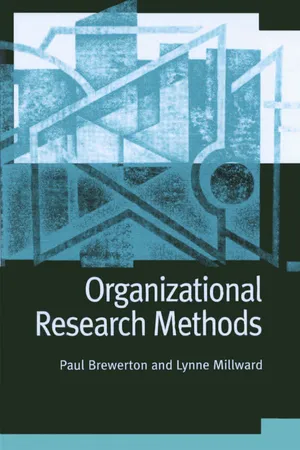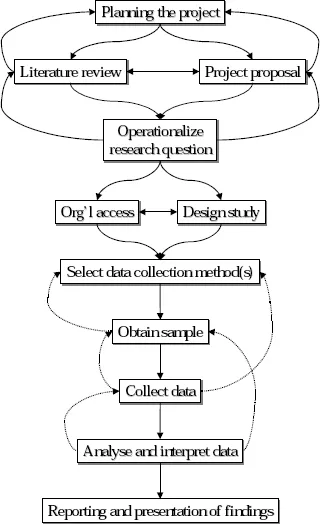
Organizational Research Methods
A Guide for Students and Researchers
- 224 pages
- English
- ePUB (mobile friendly)
- Available on iOS & Android
Organizational Research Methods
A Guide for Students and Researchers
About This Book
`This text provides a timely and comprehensive introduction to major research methods in the Organizational sciences. It will be a boon to all students conducting their projects in this area, and may well become a standard reference for staff teaching research methods to undergraduate and postgraduate students of business studies or organizational behaviour? - Professor Neil Anderson, Goldsmiths College, University of London
?This reasonably priced text would provide an invaluable starting point for those considering undertaking research in organisational settings? - Paula Roberts, Nurse Researcher
This book provides the reader with clear pointers for how to conduct organizational research appropriately, through planning and making informed and systematic research decisions, to understanding the ethical implications of applied organizational research, to implementing, reporting and presenting the findings to the highest possible standards. It provides an overview of a wide variety of research strategies, methods of data collection (both qualitative and quantitative) and analysis in a volume accessible to both an undergraduate, postgraduate and practitioner readership alike.
Organizational Research Methods also represents a useful aid to the report writing task, indicating ways in which the project material can be most effectively organised for academic and feedback purposes, and by drawing upon real-life organizational contexts and examples to help the reader understand the core issues. Finally, the book offers a clear, manageable procedure for preparing a presentation to an academic or an organizational audience.
Providing practical guidance on all elements of the research process, this book will be essential reading to all undergraduate and postgraduate students, as well as researchers, in psychology, organizational studies and management disciplines.
Frequently asked questions
Information
1 |
Introduction |
1.1 Research in organizations: debunking the myths
1.2 Objectives of the book
- Plan and make informed and systematic research decisions;
- Gain access to organizational settings;
- Understand the ethical implications of applied organizational research;
- Select appropriate methods for collection and analysis of organizational data;
- Implement, report and present the findings of meaningful applied research with a view to achieving the highest of academic and professional standards.

1.3 The role of the researcher
- Objective – in practical settings, the researcher is likely to enter the organization as an outsider, or third party, and will need to retain objectivity throughout the research process, regardless of external pressures and the method(s) selected for generating and gathering data from the participating organization.
- Scientific – the researcher will need to think critically and objectively at all times, examining the research question posed in detail and leaving ‘no stone unturned’ in seeking answers to that question.
See Chapter 2 – Applying Social Science to the Real World – for more on the science of research. - Creative – any research effort is likely to require the researcher to think ‘outside the box’ in order to generate a testable research hypothesis, for example, to identify a suitable project design or method for data collection, and to accommodate the differing agendas of academic and applied research.
Chapter 5 – Project Design and Chapter 6 – Methods of Data Collection, discuss in depth the various approaches which can be taken when addressing a research question. - Ethical – the researcher must be conscious of and respect any ethical issues raised. Research projects involving participants of any kind are likely to raise expectations, or have other implications for the organization or the participants involved. Confidential information gained from whatever source must remain confidential, and the researcher must retain a high degree of integrity in conducting research within a ‘live’ setting;
Chapter 5 – Project Design outlines some of the key ethical issues which the prospective researcher will need to consider. - Manager – project management is critical to the successful execution of the research process. The researcher must be well organized, setting realistic deadlines and milestones, meeting representatives from the participating organization on a regular basis and communicating progress. In an academic environment where there are numerous pressures on the student to spread his/her time across multiple projects, management of this kind is invaluable to ensure that the project remains on track.
Chapter 3 – Starting off the Research Process – outlines the basic tenets of project management and provides some guidelines for using project management principles when developing a research proposal and plan. - Salesperson – it may be that organizational access can only be secured by ‘selling’ an idea to a potential participating organization. This requires an articulate statement of the aims of the research and its practical significance, particularly in terms of tangible benefits for the organization. At the same time, the researcher needs to be sure not to overstate these benefits in order that the organization retains realistic expectations of what is being offered.
Chapter 4 – Obtaining and Using Access to an Organization – explains how to ‘sell’ your research into an interested organization and how to manage the relationship with that organization throughout the research process. - Data gatherer and ‘synthesizer’ – the researcher will be called upon to gather and interpret large amounts of information during the early stages of the research process (particularly during the literature review). It is crucial that the researcher is able to analyse and synthesize this information rapidly and critically, identifying key issues and how they might impact on the research question.
Chapter 3 – Starting off the Research Process – discusses in detail the literature review and its role in the research process. Chapter 6 – Methods of Data Collection – provides details of the many and varied methods available to the organizational researcher. - Data analyst – analysis of data gathered is an integral part of the research process and the researcher will need competence in qualitative and quantitative analytic methods. It is likely that this will involve at least some bivariate or multivariate statistical analysis.
Chapter 9 – Data Analysis – provides some pointers as to which statistical tests (or other forms of data analysis) should be used when analysing and interpreting project findings. - Presenter – the researcher will need to be able to present and communicate research findings in a digestible and appropriate way, depending on the audience (i.e. academic or organizational). This will require honed interpersonal skills for one-to-one or group presentations to participating organizations, in addition to scientific writing skills for the preparation of the project report or dissertation.
Chapter 10 – Reporting Research Findings – gives some detailed guidance on how to construct research reports and presentations tailored to a particular target audience.
1.4 References and further reading
2 | Applying Social Science to the Real World |
2.1 Introducing the scientist–practitioner model
- Research as a formal activity pursued in the form of a specific project with a clear beginning and a clear end (e.g. research into the antecedents of turnover decisions in nursing staff);
- Research-based practice – i.e. drawing on the knowledge base of the discipline in an informed and critical way (e.g. uncovering motivations to leave their employing organisation in order to improve retention of nursing staff and overall performance of NHS Trusts);
- Application of knowledge, experience and skill using the research process, i.e. systematic practice based on inquiry, a process of hypothesis formulation and testing, and model development (e.g. building a model of nursing turnover synthesizing theory and practical findings, obtained through application of appropriate data collection and analysis methods).
Table of contents
- Cover Page
- Title
- Copyright
- Contents
- List of Figures
- List of Tables
- List of Boxes
- List of Case Studies
- Preface
- 1 Introduction
- 2 Applying Social Science to the Real World
- 3 Starting off the Research Process
- 4 Obtaining and Using Access to an Organization
- 5 Project Design
- 6 Methods of Data Collection
- 7 Sampling Considerations
- 8 Assessing Performance in Organizations
- 9 Data Analysis
- 10 Reporting Research Findings
- 11 Concluding Words
- Glossary
- Index